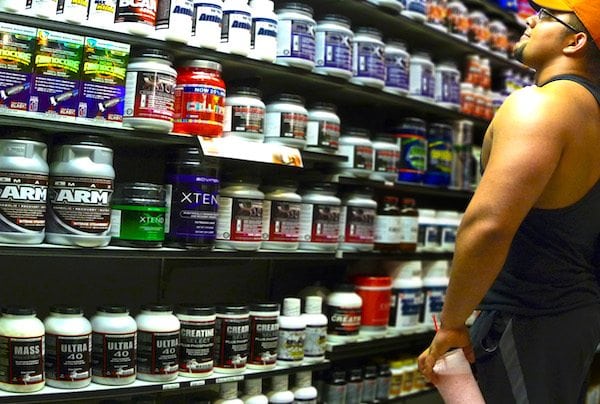No products in the cart.
How To Gain Muscle Fast (for Skinny Guys) : Tips for Hardgainers

Being skinny is a bit of a gift and a curse, you’ll never have to worry about your ever-expanding waistline, but on the other hand, you’ll probably struggle to build some serious size.
The first thing that you should realise is that being skinny is all down to energy balance.
You may feel like you’re cursed and that there is nothing that you can do to gain muscle, but this is incorrect.[toc]
Energy Balance
To gain weight all you need to do is ensure that you are consuming more calories than you are expending.
So before starting your new regime, it is important to get a good idea of how many calories you are burning per day.
Measuring your daily step count, and entering in your statistics into a calculator such as this one from precision nutrition [1] will give you a good idea of what your basal metabolic rate is, and how many calories you typically burn through exercise/walking.
This will only give you a rough idea of your average calorie expenditure. This is a good start, and you can always (and should always) adjust this as time passes.
Let’s say that you are currently burning 2,500 calories per day – this comes from your basal metabolic rate (how many calories your body burns just to function), your step count throughout the day, and from an hour’s workout each day.
If you consume just 2,000 calories per day on average you will lose weight. While if you were to match the 2,500 calories you would maintain weight. This is known as a neutral energy balance.
But as you are looking to gain weight (i.e. gain muscle) you will need to create an energy surplus by eating more than 2,500.
How much more you eat will depend on several factors:
- How quickly you want results
- The time you can dedicate to training each day
- How much excess body fat you can gain without worrying
- The number of calories you are already consuming on average
If you are skinny and have always been skinny then we can assume that you have been maintaining weight for quite some time, meaning that your average calorie intake is probably 2,500.
To create a surplus we could add between 10% and 20% calories, or 250-500. At the higher end of the scale, this would mean eating 3,000 calories rather than 2,500 calories. A surplus of 500 calories per day.
Being so aggressive with calories may lead to some unwanted fat accumulation as you bulk, but you will see fast muscle-building too.
If you want to minimise fat gain then you can be more conservative with the number of calories that you add, maybe try +50 calories each week? But remember that the title of this article is “how to gain muscle fast (for skinny guys)” so we aren’t looking at the slow and steady option!
How to Hit Your Calorie Target

Adding 500 calories to your diet can seem like a daunting prospect. There are many ways to do this, but the first thing that you should do is assess what your current diet is like, and make any adjustments that you deem necessary.
For example, a lot of skinny guys tend not to be too consistent in their eating habits.
They may skip breakfast or lunch, or overeat on the weekend but under-eat Monday to Friday.
To hit your new calorie target you are going to need to be eating three main meals each day, with snacks in between, and possibly a pre-bed snack too.
You are going to need to track your calorie intake each day, track your calories burned, and consistently stick to this routine day in, day out, for a prolonged period of time.
You can make things easier on yourself by standardising your breakfast, and possibly your lunch too.
Have the same foods each day, so that you know exactly how many calories you have consumed by midday.
Look for foods that are high in protein, and also contain decent amounts of carbohydrates and fats.
You can fill gaps in your diet with supplements such as protein shakes, mass gainers, and high protein snacks (protein bars, protein ice cream etc).
If you are trying to hit a very high-calorie target then you should definitely not follow any diet that restricts carbohydrates or fats. Attempting to hit 3,000 calories per day without carbohydrates is going to be really difficult, and is completely unnecessary.
Clean Vs Dirty Bulk
A common question by people who are looking to increase their size (bulk) is whether they should do so using a clean or dirty bulk.
A clean bulk is where you increase calories using only foods that have been designated “clean”. Think chicken, white rice, broccoli. A clean bulk will involve cooking foods from scratch, avoiding all “processed” or junk food, and attempting to eat only organic, plain food.
A dirty bulk is a more commonly used method – particularly among bodybuilders who may have chemical assistance. It’s also a lot more fun!
Dirty bulks involve eating as many high-calorie foods as you can and don’t tend to bother with tracking calories. Essentially your goal is to eat as much as you possibly can, just keeping an eye on protein levels.
The downside of the clean diet is:
1) How boring it is.
2) How difficult it can be to eat enough and hit your calorie targets.
It’s a good way to increase calories while staying disciplined, but it is also very hard to complete because it is so dull. Also, clean foods is a completely subjective thing with no real consensus.
The downsides of a dirty bulk are numerous:
1) Poor nutrition due to most junk food being low in vitamins and minerals.
2) Increased fat accumulation due to high-calorie foods not being tracked.
3) Poor habits being formed, it can be very difficult to go from a dirty bulk back to regular eating.
Neither form of bulk is completely without merit, but nor is either bulk ideal.
To get the best results you should not employ a clean bulk or a dirty bulk, you should instead use a flexible dieting approach.
Track your calories and macros, and eat whatever foods help you to hit those targets. You’ll quickly find that eating too much junk food will completely skew your macros, so you’ll self-correct.
It will be mostly comprised of healthy foods, with the odd unhealthy food being allowed. This approach is not too strict so is easier to follow. It is also structured enough to prevent too much fat accumulation, which is an issue for dirty bulks.
Supplementation

It is entirely possible to build muscle without supplements, and you should ensure that you are not relying on expensive supplements to get results.
At best a supplement will contribute 10%, but usually, it’s lower than that!
One exception to that is whey protein powder (or similar protein powders) as these can really help boost your daily protein intake.
Whey Protein
The most commonly bought supplement on the planet, an essential product for anyone looking to build muscle.
Studies have repeatedly shown that high protein diets can help build muscle, a serving of 20g of whey protein is sufficient to stimulate protein synthesis and start the process of increasing muscle size [2].
Casein Protein
While whey protein is a fast-releasing form of protein, casein is slow-releasing. Making it excellent as a pre-bed shake, or taken between meals.
A 2012 study in Medicine & Science in Sports & Exercise found that taking casein protein immediately before bed can help stimulate protein synthesis after a workout [3].
Creatine
Particularly useful for vegan or vegetarian people looking to build muscle (due to almost all creatine coming from meat). Creatine is a synthetic supplement that helps to increase energy and help you lift heavier and for longer.
Combining creatine with whey protein can lead to even greater results [4].
Caffeine/Pre Workout
A good pre-workout supplement is not necessary for optimal muscle gains, but it can certainly help.
Many pre-workouts contain caffeine as it is so effective at improving performance in the gym, but you can just take pure caffeine pills (or drink a black coffee).
You can also get pre-workouts that contain creatine which helps you to kill two birds with one stone (literally if you take enough!).
Rest & Recovery
Optimal rest and recovery is a massive influence on your results. It is so often overlooked by skinny guys who want to get bigger.
Professional sportsmen and women will probably sleep between eight and ten hours each night (or a combination of sleep and naps during the day). This is to help them recover from arduous workouts and build muscle.
It also helps them focus better and train harder the next day.
So if you are trying to build muscle, but constantly only sleep 4-6 hours per night, then you may struggle to see any results.
Poor sleep can lead to reduced testosterone. Low testosterone levels mean that you will struggle to build muscle, as it is required for muscle protein synthesis. Bad sleep can also lead to reduced growth hormone levels.
Other forms of recovery such as increasing protein intake (discussed earlier) and stretching/foam rolling to reduce muscle stiffness can help to improve your performance the next day – which will help to speed up those muscle gains.
Training For Bigger Muscles

There are many different reasons why people train, the most common are:
- Fat loss
- Improved health
- Improved sporting performance
- Increased strength
- Increased muscle size (also known as hypertrophy)
If you are looking for bigger muscles then you should only concern yourself with the final option.
Training for hypertrophy has its own unique methods that differ from the others.
Compound Lifts v Isolation Lifts
Compound lifts are ones that work multiple muscles at one time. For example, the barbell bench press works the chest, shoulders, and triceps.
An isolation lift concentrates on just one major muscle (though minor muscles may also be used to some small extent). A dumbbell bicep curl is a great example as it works the biceps muscle almost exclusively.
If you were training for fat loss you would avoid isolation lifts. If you were training for strength you would also avoid them for the most part.
When training for hypertrophy, however, you need to add more isolation movements into your program. You can still mostly focus on compound movements, but definitely add some isolation exercises into your program.
Inter-Set Rest Periods
When training for fat loss, the idea is to keep the intensity high throughout the workout to maximise the number of calories burned. This means keeping rest periods short, usually between 45-60 seconds.
If strength is your goal then you should be increasing rest periods to between 3 and 5 minutes.
For a long time, people thought that hypertrophy training required less time than strength training, and was actually closer to fat loss when it came to rest times. But actually, the added recovery time leads to better muscle size increases. So keep your rest times to three minutes.
Rep Ranges
If strength is your goal, then your rep ranges should be around 1-6 reps per set as a maximum.
If you are training for muscular endurance, then your rep range should be 15-25 reps per set (or even higher). Hypertrophy training used to be seen as a medium rep range of 8-12 reps per set. But actually, it can benefit from lots of different rep ranges.
The majority of your training program should have rep ranges of 8-12. You can also throw in some low rep sets and lots of higher rep sets. Don’t be afraid to chuck in some 20+ rep sets too!
Training Techniques
Muscle hypertrophy is caused by many factors. One of the most common is fatiguing the muscles.
Because of this, techniques such as drop sets, supersets, and back off sets can be really effective when added strategically to your training program.
If you are training unassisted (no steroids etc) then you won’t be able to use them as often as your favourite bodybuilder does. Once or twice per session won’t hurt.
A drop set is where you perform a set of (let’s say) 10 reps. This is usually the last set of three. When the set finishes you would usually rest. But with a drop set, you would immediately lower the weight by 25-40% and then start again (with as little rest as possible). Then you would perform as many reps as possible at the lighter weight.
Sometimes people, won’t stop there either. They will continually lower the weight and repeat the exercise until they have reached complete muscle failure.
A superset is where you pair two exercises (usually ones that work opposing muscle groups such as chest and back) and instead of resting you just switch to the opposite exercise.
An example of this would be performing a set of bench press and then immediately performing a set of bent-over rows.
You can also superset with exercises that work the same muscle group (so bench press and push-ups).
A giant set is where you perform 3-4 exercises that all target the same muscle group – often from different angles. For example, a shoulders giant set could involve a seated shoulder press, rear delt flys, front raises, and barbell shrugs.
A back off set is similar to a drop set, but with a couple of differences. Let’s say that you are performing three sets of bench press at 100kg for 6 reps (because you’re super strong). After the third set, you would reduce the weight to 50%, which in this scenario would be 50kg.
Instead of immediately jumping in like you would in a drop set, you wait for three minutes just like you would for a 4th set. Then you perform the exercise with a nice smooth, slow action, for as many reps as you can.
Final Thoughts
Now that you have an idea how to train (just create yourself a program that follows the rules above), how to eat, what supplements to buy, and the best ways to recover from intense exercise, you can get started.
Be patient, take constant progress photos, measurements, and make adjustments to your diet and training program when you feel it is necessary.
You may need to go on a cut (where you lower calories below baseline) afterwards to remove some of the body fat that you have accumulated during your bulk. However, if you’ve done everything correctly and been sensible with your calorie targets then you shouldn’t have much work to do.

Looking for advice on whey protein. Which one would you recommend?
Hi Paul. Personally, I would recommend the whey protein sold by Battle Ready Fuel. 🙂